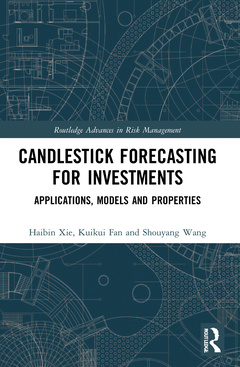Description
Candlestick Forecasting for Investments
Applications, Models and Properties
Routledge Advances in Risk Management Series
Authors: Xie Haibin, Fan Kuikui, Wang Shouyang
Language: English
Subjects for Candlestick Forecasting for Investments:
Keywords
Out-of Sample Forecasting; Dry Trading; Candlestick Chart; Options; Technical Range; Forex; Classic ARMA Model; Stock Market; ARMA Model; investment practitioners; Sic Criterion; statistical properties; Closing Price; range decomposition technique; Co-integrating Vector; candlestick forecasting; VECM Model; Candlestick charts; Granger Causality; Out-of Sample Period; Unit Root Process; Out-of Sample Predictability; Forecasting Power; Model Stock Return; GARCH Equation; Information Spillover Effect; GJR GARCH Model; Out-of Sample Forecasting Results; Bi-directional Granger Causality; Technical Trading Rules; Moving Average Trading; Bidirectional Granger Causality; Forecast Error Variance; Cm Test
50.12 €
In Print (Delivery period: 14 days).
Add to cartPublication date: 09-2022
Support: Print on demand
166.30 €
In Print (Delivery period: 14 days).
Add to cartPublication date: 03-2021
· 15.6x23.4 cm · Hardback
Description
/li>Contents
/li>Readership
/li>Biography
/li>
Candlestick charts are often used in speculative markets to describe and forecast asset price movements. This book is the first of its kind to investigate candlestick charts and their statistical properties. It provides an empirical evaluation of candlestick forecasting. The book proposes a novel technique to obtain the statistical properties of candlestick charts. The technique, which is known as the range decomposition technique, shows how security price is approximately logged into two ranges, i.e. technical range and Parkinson range.
Through decomposition-based modeling techniques and empirical datasets, the book investigates the power of, and establishes the statistical foundation of, candlestick forecasting.
PART I INTRODUCTION AND OUTLINE1. Introduction 1.1 Technical analysis before the 1970s 1.2 Technical analysis during 1990s–2000s 1.3 Recent advances in technical analysis 1.4 Summary 2. Outline of this book PART II CANDLESTICK 3. Basic concepts 4. Statistical properties 4.1 Propositions 4.2 Simulations 4.3 Empirical evidence 4.4 Summary PART III STATISTICAL MODELS 5. DVAR model 5.1 The model 5.2 Statistical foundation 5.3 Simulations 5.4 Empirical results 5.5 Summary 6. Shadows in DVAR 6.1 Simulations 6.2 Theoretical explanation 6.3 Empirical evidence 6.4 Summary PART IV APPLICATIONS 7. Market volatility timing 7.1 Introduction 7.2 GARCH@CARR model 7.3 Economic value of volatility timing 7.4 Empirical results 7.5 Summary 8. Technical range forecasting 8.1 Introduction 8.2 Econometric methods 8.3 An empirical study 8.4 Summary 9. Technical range spillover 9.1 Introduction 9.2 Econometric method 9.3 An empirical study: DAX and CAC40 9.4 Summary 10. Stock return forecasting: U.S. S&P500 10.1 Introduction 10.2 Econometric methods 10.3 Statistical evidence 10.4 Economic evidence 10.5 More details 10.6 Summary 11. Oil price forecasting: WTI Crude Oil 11.1 Introduction 11.2 Econometric method 11.3 Empirical results 11.4 Summary PART V CONCLUSIONS AND FUTURE STUDIES 12. Main conclusions 13. Future studies
Haibin Xie is Associate Professor at the School of Banking and Finance, University of International Business and Economics.
Kuikui Fan is affiliated with the School of Statistics, Capital University of Economics and Business.
Shouyang Wang is Professor at the Academy of Mathematics and Systems Science, Chinese Academy of Sciences.




